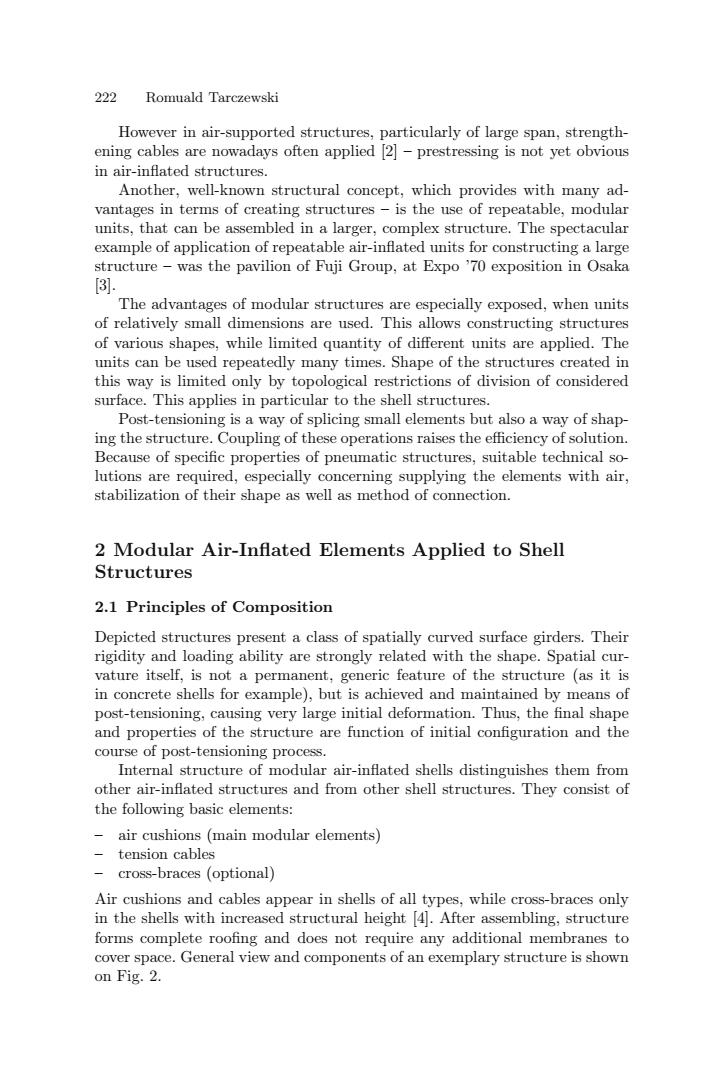正在加载图片...

222 Romuald Tarczewski However in air-supported structures,particularly of large span,strength- ening cables are nowadays often applied [2]-prestressing is not yet obvious in air-inflated structures. Another,well-known structural concept,which provides with many ad- vantages in terms of creating structures -is the use of repeatable,modular units,that can be assembled in a larger,complex structure.The spectacular example of application of repeatable air-inflated units for constructing a large structure-was the pavilion of Fuji Group,at Expo'70 exposition in Osaka 3. The advantages of modular structures are especially exposed,when units of relatively small dimensions are used.This allows constructing structures of various shapes,while limited quantity of different units are applied.The units can be used repeatedly many times.Shape of the structures created in this way is limited only by topological restrictions of division of considered surface.This applies in particular to the shell structures. Post-tensioning is a way of splicing small elements but also a way of shap- ing the structure.Coupling of these operations raises the efficiency of solution. Because of specific properties of pneumatic structures,suitable technical so- lutions are required,especially concerning supplying the elements with air, stabilization of their shape as well as method of connection. 2 Modular Air-Inflated Elements Applied to Shell Structures 2.1 Principles of Composition Depicted structures present a class of spatially curved surface girders.Their rigidity and loading ability are strongly related with the shape.Spatial cur- vature itself,is not a permanent,generic feature of the structure (as it is in concrete shells for example),but is achieved and maintained by means of post-tensioning,causing very large initial deformation.Thus,the final shape and properties of the structure are function of initial configuration and the course of post-tensioning process. Internal structure of modular air-inflated shells distinguishes them from other air-inflated structures and from other shell structures.They consist of the following basic elements: air cushions (main modular elements) tension cables cross-braces (optional) Air cushions and cables appear in shells of all types,while cross-braces only in the shells with increased structural height [4.After assembling,structure forms complete roofing and does not require any additional membranes to cover space.General view and components of an exemplary structure is shown on Fig.2.222 Romuald Tarczewski However in air-supported structures, particularly of large span, strengthening cables are nowadays often applied [2] – prestressing is not yet obvious in air-inflated structures. Another, well-known structural concept, which provides with many advantages in terms of creating structures – is the use of repeatable, modular units, that can be assembled in a larger, complex structure. The spectacular example of application of repeatable air-inflated units for constructing a large structure – was the pavilion of Fuji Group, at Expo ’70 exposition in Osaka [3]. The advantages of modular structures are especially exposed, when units of relatively small dimensions are used. This allows constructing structures of various shapes, while limited quantity of different units are applied. The units can be used repeatedly many times. Shape of the structures created in this way is limited only by topological restrictions of division of considered surface. This applies in particular to the shell structures. Post-tensioning is a way of splicing small elements but also a way of shaping the structure. Coupling of these operations raises the efficiency of solution. Because of specific properties of pneumatic structures, suitable technical solutions are required, especially concerning supplying the elements with air, stabilization of their shape as well as method of connection. 2 Modular Air-Inflated Elements Applied to Shell Structures 2.1 Principles of Composition Depicted structures present a class of spatially curved surface girders. Their rigidity and loading ability are strongly related with the shape. Spatial curvature itself, is not a permanent, generic feature of the structure (as it is in concrete shells for example), but is achieved and maintained by means of post-tensioning, causing very large initial deformation. Thus, the final shape and properties of the structure are function of initial configuration and the course of post-tensioning process. Internal structure of modular air-inflated shells distinguishes them from other air-inflated structures and from other shell structures. They consist of the following basic elements: – air cushions (main modular elements) – tension cables – cross-braces (optional) Air cushions and cables appear in shells of all types, while cross-braces only in the shells with increased structural height [4]. After assembling, structure forms complete roofing and does not require any additional membranes to cover space. General view and components of an exemplary structure is shown on Fig. 2